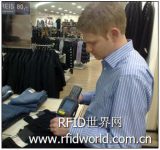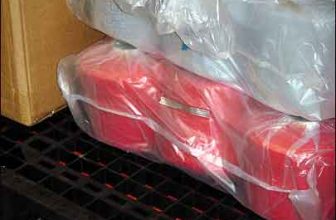
German clothing retailer Jakob Jost successfully tested RFID applications
[ad_1]
Jakob Jost is a medium-sized clothing retailer in southern Germany. The company is testing a system to track RFID-labeled clothing shipped by clothing manufacturers (from the receipt of the labeled clothing at the retailer’s logistics center to the sale of the final store). ). Jakob Jost said that this test conducted by the company in cooperation with a clothing supplier is the first case of RFID application by a medium-sized retailer in Germany.
Jakob Jost has 250 employees and sales in 2008 reached 41 million U.S. dollars. The company hopes to improve the goods receiving, inventory counting and replenishment process to ensure that customers can find the clothes they want in the company’s four retail stores. Although the company hired 10 employees to handle the goods receipt, there was still a 5% difference between the actual goods received and the delivery list. For this reason, the workers had to spend a lot of time matching the goods. Moreover, the company’s stock-out ratio reached 10%.
In order to solve these problems, Jakob Jost studied a variety of solutions and eventually joined the RFID research team sponsored by GS1 in Germany.

A Jakob Jost employee uses Nordic ID PL3000 Cross Dipole UHF handheld to check inventory
According to Patric Knoll, Jakob Jost’s business operations manager, medium-sized companies in the research group are rarely willing to take the risk of trying RFID. Therefore, the company allocated a special budget and decided to carry out the test. “The goal is to prove that medium-sized companies can also benefit from RFID applications,” he said.
According to Knoll, Jakob Jost used RFID handheld readers for testing before deciding to invest in RFID fixed infrastructure. After analyzing the test results in mid-2010, the company will decide whether to further invest in the construction of RFID fixed infrastructure or continue to use RFID handsets.
Jakob Jost selected Austrian RFID retail solution provider RF-iT Solutions and security system company ADT to help implement this project. RF-iT Solutions provides services such as labeling, goods receipt and mobile inventory counting, while ADT purchases and maintains RFID hardware equipment.
In December 2009, Jakob Jost began to use handhelds to read labelled clothing from suppliers at three points in its supply chain.
The company is already tracking 2,000-3,000 garments from Gardeur, a major German manufacturer of men’s and women’s trousers (the company has been using RFID tags since 2006) and children’s clothing manufacturer Lemmi. In January 2010, the company began tracking 6,000 pieces of clothing supplied by Seidensticker. By mid-2010, the company also plans to track the garments of Gerry Weber (which has embedded RFID in the maintenance labels of production garments), and Monti’s ties, belts and accessories.
Except for Gerry Weber garments, all labelled garments shipped to Jakob Jost have EPC Gen 2 RFID tags embedded in the garment tag, and the tag prints product information in the form of text and barcode. Gerry Weber sewed the RFID tag into the clothing care instruction label instead of embedding it in the tag. Jakob Jost doesn’t want to label clothes himself, Knoll said.
The first reading of the label occurred when Jakob Jost received the goods at the Grünstadt distribution center. When the box containing the labeled garments is delivered from Gardeur, Lemmi or Seidensticker, the workers use Nordic ID’s handheld RFID readers to read the garment tags without removing the garments from the box. For unlabeled goods, workers still use barcode scanners to identify each piece of clothing and compare it with the list of goods. Since launching the RFID test, Jakob Jost stated that the company has not shown any discrepancies between the invoice and the actual labelled items. If there are indeed discrepancies, workers will manually inspect the garments and compare them to the invoice.
The second reading point occurs when the goods are shipped from the distribution center and are ready to be shipped to the four stores in Jakob Jost. Workers in the distribution center use a handheld computer to read the labels of the outbound goods, so that the computer system automatically updates the location and description of the outbound goods.
The last reading point occurred in four stores. In the store, workers use hand-held readers to perform inventory counts of labeled goods once a week. Non-labeled clothing is scanned once a year with a barcode scanner. Once the labeled clothing is identified, Jakob Jost receives a confirmation message-the goods that have left the distribution center have been sent to the store.
Knoll said that the company is still working to solve some technical problems. For example, when a labeling clothing supplier sends shipping information (such as EPC data) to Jakob Jost, the information is moved to an RFID clothing device, which sends the data to Jakob Jost. Handheld machine that handles the receipt of goods. However, workers must first find out from a list of Serial Shipping Container Codes (SSCC) that they will identify the container before reading the labelled cargo. According to Knoll, this process is time-consuming and cumbersome. If the company has a large number of labeled goods to be read, the process cannot continue.
According to Tom Vieweger, key account manager of RFiT Solutions’ German office, RFiT Solutions has developed a software specifically for this purpose. “Operators scan the shipped goods, and the software can filter the data according to the registered EPC code and point to the SSCC to which the EPC code belongs. This means that workers no longer need to search for the SSCC code. On the contrary, after scanning a few pieces of goods, the SSCC will automatically appear in the handheld On board,” he said.
Jakob Jost plans to provide inventory data to its suppliers so that they can manage the replenishment of goods. However, this system has just been launched and cannot achieve this. “Suppliers cannot process serialized inventory data in electronic data interchange (EDI) information” Vieweger explained, “German GS1 has discussed and defined a new EDI standard for serialized information. At the same time, we are also developing a serialized electronic inventory report Data exchange so that we can start sending data at the beginning of this year”.
The weekly inventory count allows Jakob Jost and the apparel manufacturer to more accurately understand the inventory situation, thereby avoiding shortages.
[ad_2]




